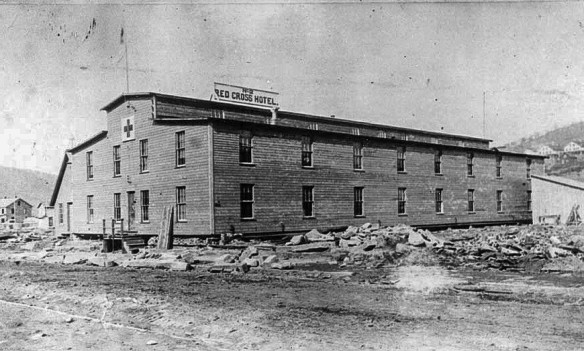By Doug Bardwell, American Red Cross volunteer
Just before 3 p.m. on May 31, 1889, 14 miles west of Johnstown, Pennsylvania, a dam broke, releasing 20-million tons of water into the Conemaugh Valley. In this narrow valley, the water reached 60 feet high as it barreled toward the city at speeds of 40 m.p.h.
By the time it struck Johnstown, the 4 billion gallons of water brought with it everything in its path. Four square miles of downtown were completely obliterated by the crushing flood waters. By the time it was over, 30 acres of human bodies, homes and debris were piled 70 feet high against the stone-arched railroad bridge at the far edge of town. The pressure and amount of the water was later compared to all the water flowing over Niagara Falls in 36 minutes.

Photo credit: Johnstown Flood Museum
Between the force of the water and the ensuing explosions and fires that broke out, more than 2,200 people died, 1,600 homes were destroyed, and $17 million worth of damage was done (close to $500 million in today’s valuation.)
From War Relief to Disaster Relief
In Washington, D.C., Clara Barton got word of the event. Prior to this time, she had provided relief to the Civil War soldiers, but was lobbying for the American Red Cross to provided relief for peacetime disasters as well. Five days after the flood, Clara and five Red Cross workers arrived in Johnstown. Within days, she had assembled a team of 50 doctors, nurses and relief workers.
Setting up headquarters in the city, she immediately began organizing donations that began arriving from all around the world. Food, clean water and supplies were passed out immediately to survivors as they tried to create shelters however they could.
“Red Cross Hotels” were opened to provide shelter for those left homeless before the winter weather set in. The first “hotel” was so successful, five more were quickly erected.

Photo credit: U. S. National Park Service
They also began building 3,000 “Oklahoma houses,” a type of prefabricated home, to aid the city in rebuilding. Furniture donations and domestic items were then organized and distributed to outfit these homes.
Clara didn’t leave the city for five straight months, only returning to Washington on October 24, 1889. The city presented her with a number of gifts to show their lasting gratitude. One editorialist wrote, “Too much cannot be said in praise of this lady…To her timely and heroic work, more than that of any other human being, are the people of the Conemaugh Valley indebted.”
Today if you visit the Johnstown Flood Museum, you’ll see a section devoted exclusively to Clara Barton and the Red Cross’ success in helping restore the town, along with some of her original papers and one of the first Red Cross blankets to be distributed.

Photo credit: Doug Bardwell/American Red Cross
Based largely on the success of her mission to aid the Johnstown residents, the American Red Cross received its Congressional Charter 10 years later, in 1900.
Today you can continue the legacy of Barton and volunteer to help with the next big disaster to strike this country. Volunteer today at https://neoredcross.org/volunteer/.
Access the ProVia Employee Red Cross Volunteer Application here.
